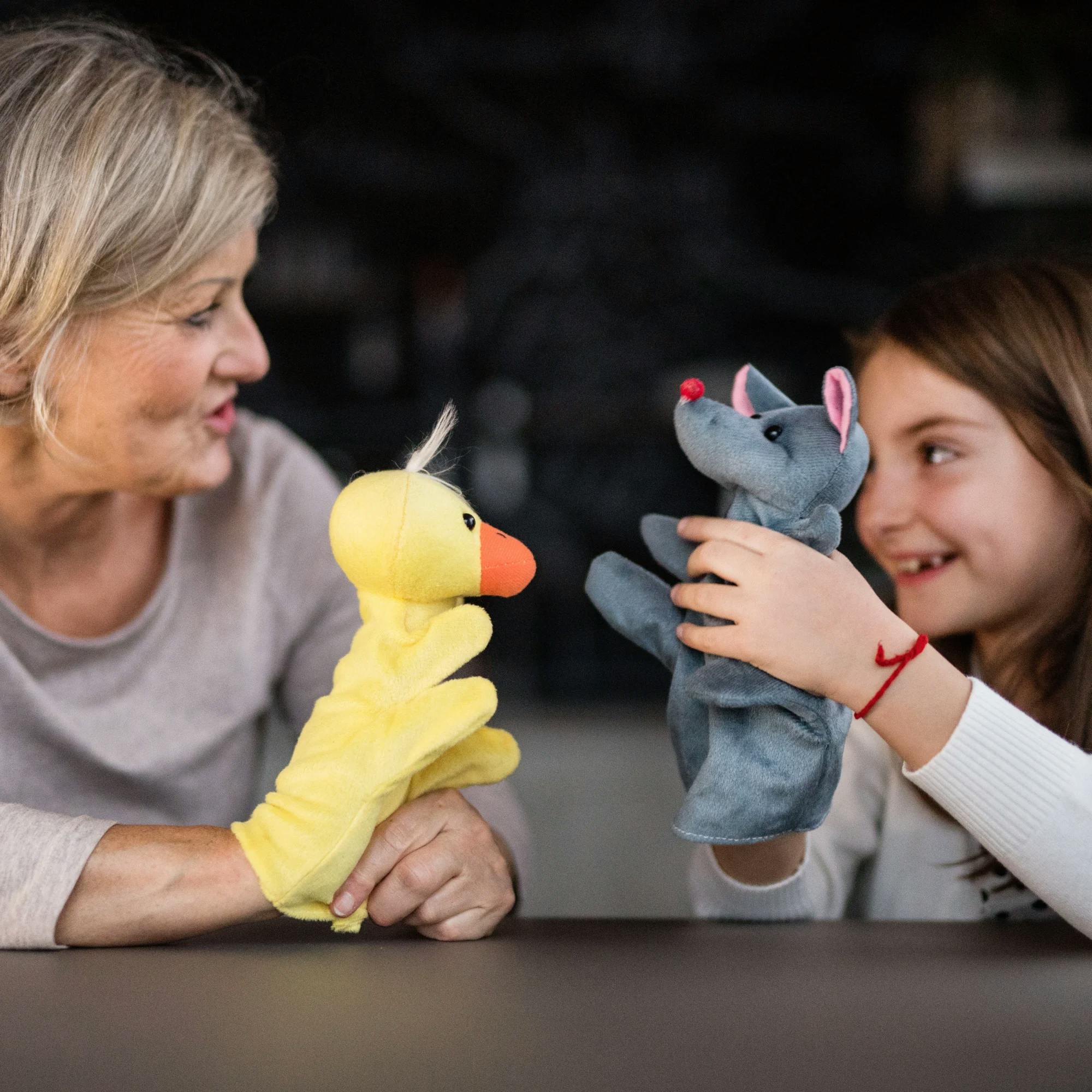Errors pronouncing the “TH” sound show up often in children’s speech. While many children will eventually be able to make the "TH" sound correctly on their own, some kids need extra help.
This article explains what "TH" sound errors might sound like and how to practice "TH" sounds with your child at home. Let's get started!
Free speech check
How well is your child speaking for their age? Find out with our free 5-minute online screener. No signup required, just answers.
 Start the screener
Start the screenerTypes of “TH” sounds
We'll start with the basics. Did you know there are two distinct types of "TH" sounds?
The voiceless "TH" sound, as in "think"
The voiced "TH" sound, as in "they"
Say both of these words out loud and you'll notice the difference. When we pronounce the word "think," we produce more air during the "TH" sound. With the word "they," you don't hear as much air.
Why is this? When we say the voiceless “TH," our vocal folds do not vibrate while producing this sound. However, when saying the voiced "TH," our vocal cords are functioning. This causes the less breathy sound you hear.
Try saying "think" and "they" again, but this time place your hand on your throat during the "TH" production. Notice that when saying "they," you're able to feel your vocal folds vibrating. Pretty cool, right?
The use of the vocal folds is the only difference between these two sounds. For both productions, the tongue protrudes slightly through the top and bottom front teeth.
Examples of voiceless "TH" words
Thorn
Thousand
Bathtub
Toothpaste
Math
Tenth
Examples of voiced "TH" words
That
Them
Mother
Bathing
Breathe
Speech errors with the “TH” sound
There are a couple different sound errors that a child may make for “TH.” Typically, an /f/ or /d/ sound is produced instead. Here are two examples:
“Father” may be pronounced as “fa-der”
“Think” may be pronounced as “fink”
When should children be able to say the "TH" sound?
A child should be able to say the voiceless “TH” sound sometime between ages 4.5 and 7 years old, and the voiced “TH” sound between 5 and 8 years old.
While this speech sound may come later for some kids, it's wise to monitor any speech errors before a child goes to kindergarten. If a child isn't showing at least some improvement of “TH” by this age, considering speaking with your pediatrician or a speech therapist.
How to start practicing the "TH" sound
When teaching the "TH" sound, it's important to start simple and progress slowly as your child improves their skills. Below is the typical progression speech therapists use to teach the "TH" sound, with some tips and tricks to practice. Before moving on to each level, be sure your child is about 90% accurate with the skills they're working on. This will ensure that the productions aren't too difficult and your child stays motivated and encouraged!
Teaching the "TH" sound by itself
Before you child can use words with the “TH” sound, they must first learn to accurately produce the sound by itself, in isolation. Unlike some other sounds, like /r/, the “TH” sound is highly visual--you can see your mouth make it. To start, put your tongue between your teeth and blow air at the same time. Notice how that naturally makes a “TH” sound? Model this action and have your child try to imitate. Then, practice doing this with and without your voice. For example, the “TH” in “think” sounds loud and distinct, whereas the “TH” in “they” is much softer and quieter. It’s important that your child masters both versions, but start with whichever comes easier.
Alex's story
Just a few months of therapy led to big gains in speech sounds and conversation. Now, he can better express himself with teachers and friends.
 Read Alex's story
Read Alex's storyTeaching the "TH" sound in syllables
After your child can imitate the different “TH” sounds, combine it with a syllable. While we’re not quite ready to practice “TH” words yet, this next level of complexity is important for your child to master. Again, model different syllable combinations and have your child practice imitating you. Start with sounds like “they, the, thee, though, tha.” Then, try putting the vowel in front of the "TH" sound, like “ath, eeth, ith, oath,” as well as in the middle: “atho, ethee, ootha.” Make sure to build upon the vowel placements your child is having the most success with before going on to harder combinations.
Teaching the "TH" sound in words
One your child can accurately pronounce "TH" sounds with syllable combinations about 80% of the time, it’s time to start practicing “TH” words! This is an exciting milestone and gets your child one step closer to using “TH” words fluently in conversation. Did your child have most success when the vowel came before, in the middle, or at the end of the “TH” sound? Build on this momentum and start by choosing words to practice that use your child's strengths. This will give them more motivation to practice!
Follow your child’s lead and practice “TH” words during an activity they most enjoy. You can print out cards with “TH” words and corresponding pictures, and play games like Go Fish or Bingo. Or, you can play a standard board game and practice “TH” words between every turn. Don’t forget to reward your child for all their hard work!
Concerned about your child's speech?
We're here for you. Get matched with a speech therapist who's experienced in your child's area of need and available when you are.
 Find a speech therapist
Find a speech therapistTeaching the "TH" sound in phrases and sentences
Once your child can say “TH” words, both voiceless and voiced, with 90% accuracy, it’s time to move on to phrases and sentences. Some children may be able to pronounce a word correctly by itself versus when that word is used in the middle of a phrase. That’s why this step is so crucial!
One great way to practice is with a Mad Libs-style activity. You can print out a Mad Libs worksheet from the internet, and then have your child populate the story with only “TH” words. Sure, the story most likely won’t make much sense, but it’s great practice, and reading over the final product often gets a hearty laugh. You can also come up with sentences for your child and have them repeat them back to you. Make sure to continue practicing until they’ve mastered “TH” productions in the beginning, middle, and end of words.
Teaching the "TH" sound in conversation
Now your child is ready to use “TH” words in conversations. Your child has worked so hard to get to this point, and this last step puts all their newfound skills into practice! To practice, simply hold conversations with your child and listen closely to their “TH” productions. It should go rather smoothly, but from time to time you may have to provide a reminder or prompt them with a correction. That’s all part of the learning experience! If they’re struggling with conversation, have your child retell simple stories they’ve just read in a book or seen in a movie.


Tips for pronouncing the "TH" sound
If your child is struggling with their "TH" productions, a speech therapist can offer more guidance that's tailored to their needs. However, these simple tips may help.
Use a mirror
When helping your child with their “TH” sounds, grab a mirror! As mentioned, the great thing about the "TH" sound is that it's easy to see because of the obvious tongue placement. Review the correct tongue placement in front of the mirror with your child and have them imitate what your mouth and tongue are doing.
Try the discrimination technique
With this speech therapy technique, your child has to point out when you say a word right or wrong. Have your child watch your mouth and listen to the word. They can give you a thumbs up for a correct production, or a thumbs down for an incorrect production. Make sure your child is doing well with discrimination before moving on to actual saying the sound themselves.
Pick the voiced or voiceless “TH” sound to start
When you're beginning to target “TH” sounds with your child, pick either voiced or voiceless “TH” to start, and focus on that one. Since working on new sounds can take a lot of practice for children, it's ideal to focus on one at a time.
Practice the "TH" sound often!
Practice has to be consistent in order for progress to happen. So be sure to practice at least 3 times a week. Having repeated exposure to speech goals will help your child make more progress faster.
While practice is important, be sure to find ways to make it fun and engaging for your child. Speech practice should be a positive experience!


Help your child use the "TH" sound in everyday speech
As you continue to practice, it's common for your child to master their "TH" sounds in words, phrases, and sentences, only to struggle applying this new sound to everyday speech. Parents and caregivers report this often.
In order to increase correct productions of “TH” words, you can start by having your child identify “TH” words that they hear in speech. This can be words they hear you or other family members say, or even words in their own speech. When a child is more aware of “TH” sounds in connected speech, they are more easily able to self-correct their own sound production.
Once your child starts practicing “TH” in conversation, tell your child, “I’m going to be listening for your good 'TH' sounds!” This helps prompt them with an initial reminder. Spend about 10 minutes talking with your child, and point out any mispronunciations they may need to repeat.
Over time, decrease how frequently you remind your child that you're listening for their “TH” production. This will help them become more and more independent with this sound production. Once a child masters the conversational level, they've met this goal!
Find a speech therapist for your child
You don't have to go it alone. A licensed speech therapist can diagnose your child's speech issue and develop a treatment plan specific to their needs. With online speech therapy in particular, it's easy for parents to be involved in their child's care and learn how to help them at home, between sessions.
Not sure how to get started with speech therapy? Click here to get matched with a speech therapist for your child. We'd be happy to answer your questions and help you decide on the next steps that are right for your family.
How Expressable Can Help
Concerned your child isn't reaching age-expected milestones? Looking for communication support from a professional? Expressable is a national online speech therapy practice serving children and adults. We treat all major areas of communication and feeding, offer flexible hours including evenings and weekends, and accept most major health insurance plans. We’re proud to have earned more than 3,000 5-star reviews from our clients (4.9/5 average).
Our therapy model is centered on parent and caregiver involvement. Research proves that empowering caregivers to participate in their loved one’s therapy leads to better outcomes. That’s why we combine live, 1-on-1 speech therapy with personalized education and home practice activities for faster progress.
Communication is more than words. It’s how we share how we feel and show who we are. We’re here to help you or your child do just that.

 Abby Barnes, M.S., CCC-SLP
Abby Barnes, M.S., CCC-SLP












